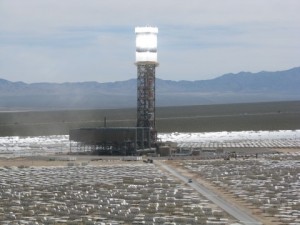forum
library
tutorial
contact

Solar Power from Giant Mirrors
Flows into California's Grid
StaffInternational Water Power & Dam Construction, September 24, 2013
|
the film forum library tutorial contact |

|
Solar Power from Giant Mirrors
Staff |
 BrightSource Energy's massive solar farm in a remote corner of California delivered its first flow of power to the grid, an important step for demonstrating that the project is on the final path to become a fully operating power plant, the company said Tuesday.
BrightSource Energy's massive solar farm in a remote corner of California delivered its first flow of power to the grid, an important step for demonstrating that the project is on the final path to become a fully operating power plant, the company said Tuesday.
BrightSource achieved what is called the "first sync" with the project, Ivanpah Solar Electric Generating System, where for the first time the steam was sent to one of its three turbines for generating electricity and synching to the grid. Ivanpah is the first commercial power plant project in the United States for BrightSource, which owns a stake in the project along with NRG Energy and Google.
The project also is one of the massive solar power projects being built in California to enable the state to meet its goal of using an increasing amount of renewable electricity. The state's mandate requires 33% of its utilities power supplies to come from renewable sources such as solar, wind, geothermal and biomass by 2020.
The project has a 392-megawatt capacity but is set to deliver 377 megawatts to the Pacific Gas and Electric and Southern California Edison . It's sized to deliver enough power to about 140,000 homes per year.
Ivanpah is made up of three power generation stations. The "first sync" milestone took place at Unit 1, and the same step will be done at Unit 2 and Unit 3 soon. Unit 2 and Unit 3 are scheduled to start delivering electricity to the grid by the end of the year.
The completion of Ivanpah will be a good proof point for a controversial federal loan guarantee program that made headlines for putting money in failed solar panel maker Solyndra and electric car company Fisker Automotive. The program set out to support innovative technologies that make use of cleaner sources of energy. New technologies are inherently risky bets, which have prompted big debates over the government's role and approach in financing green tech projects.
The loan guarantee program provided $1.6 billion to Ivanpah. The project uses a field of giant flat mirrors to concentrate sunlight to heat water in a boiler atop of a tower. The process produces steam that is then fed to a turbine generator to create electricity. BrightSource built a much smaller project to demonstrate its technology at a Chevron oil field in California. Chevron uses the steam to pry loose sticky oil in rock fissures and make it easier to pump up to the surface.
BrightSource's technology, called concentrating solar thermal, requires a large track of land for its massive equipment and bright, direct sunlight to be financially feasible. States such as California, Arizona and Nevada offer prime spots for the technology. Worldwide, concentrating solar thermal power plants have been built or proposed in Spain, India, China and the Middle East.
The need for a lot of land also makes solar thermal technology more prone to challenges from environmental groups, some of which have come to promote smaller solar energy projects that could be built closer to towns and cities that need the power. Solar panels, which have gotten cheaper in recent years, have become more popular for developers because they offer a greater flexibility for sizing a project.
learn more on topics covered in the film
see the video
read the script
learn the songs
discussion forum
